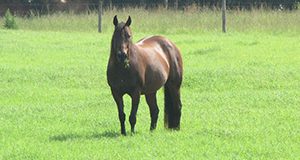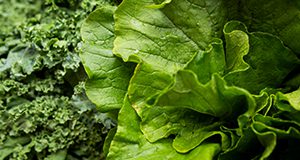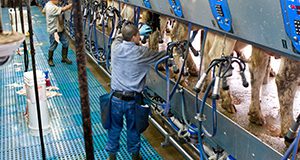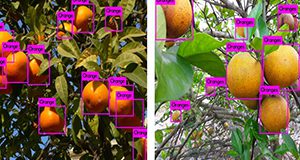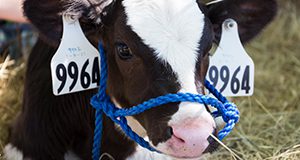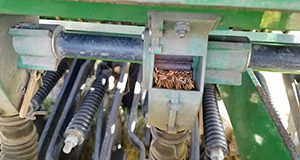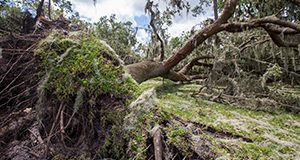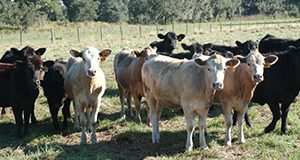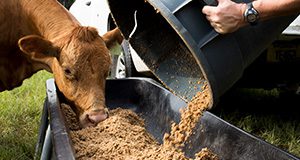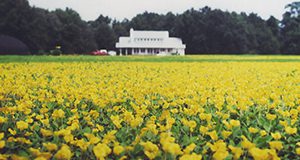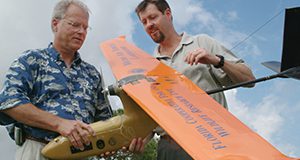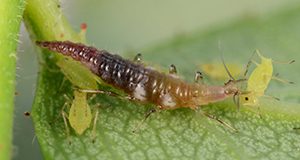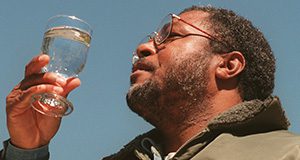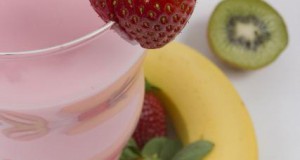Florida's unique climatic characteristics allow for forage production most of the year with a large variety of possible forage choices. Independent of the size of the operation and number of horses, good forage planning can help reduce feeding costs, environmental impacts, and nutritional disorders caused by high-concentrate feeding. With the exception of high-performance animals, horses can meet most of their nutritional needs from pasture. However, achieving this requires careful planning and implementation of a forage production and utilization program. This 9-page document discusses intake and nutrient requirements, pasture planning, forage species, and pasture management. Written by M. Wallau, E. L. Johnson, J. Vendramini, C. Wickens, and C. Bainum, and published by the UF/IFAS Agronomy Department, revised January 2019.
http://edis.ifas.ufl.edu/aa216
Author: Amanda Quintos
Overseeding Rhizoma Perennial Peanut Pasture and Hay Fields during the Cool Season
Hay and livestock producers want to know if they can overseed their rhizoma peanut fields with cool-season forages during rhizoma perennial peanut dormancy. This new 5-page document discusses overseeding for hay and overseeding for grazing. Written by Jose Dubeux, Cheryl Mackowiak, Ann Blount, David Wright, and Luana Dantas, and published by the UF/IFAS Agronomy Department, January 2019.
http://edis.ifas.ufl.edu/ag426
Alimentacion Saludable: Organice Su Plato
Planear sus comidas puede ayudar a controlar las porciones y la cantidad de carbohidratos que usted consume a través del día. Esto es especialmente importante si usted padece de la diabetes o si usted es una persona en alto riesgo de padecer de la diabetes. This 2-page document is the Spanish version of Healthy Eating: Create Your Plate. Written by Jennifer Hillan and Linda B. Bobroff, and published by the UF/IFAS Department of Family, Youth and Community Sciences, revised December 2018.
http://edis.ifas.ufl.edu/fy907
The Value of Milk Fat
In the Southeast, milk is priced based on fat and skim milk value, with additional bonuses for somatic cell and bacterial counts. In recent years, butterfat has become more valuable. This 7-page document discusses some of the history behind the changes in milk fat consumption, management factors that influence milk fat content and yield by dairy cattle, and economic implications of changing fat content through the diet in two case scenarios. Written by José E. P. Santos and Albert De Vries, and published by the UF/IFAS Department of Animal Sciences, January 2019.
http://edis.ifas.ufl.edu/an350
Applications of Artificial Intelligence for Precision Agriculture
Technological advances in computer vision, mechatronics, artificial intelligence, and machine learning have enabled the development and implementation of remote sensing technologies for plant, weed, pest, and disease identification and management. They provide a unique opportunity for the development of intelligent agricultural systems for precision applications. This 5-page document discusses the concepts of artificial intelligence (AI) and machine learning and presents several examples to demonstrate the application of AI in agriculture. Written by Yiannis Ampatzidis, and published by the UF/IFAS Department of Agricultural and Biological Engineering, December 2018.
http://edis.ifas.ufl.edu/ae529
Are Cows Comfortable in Modern Dairy Facilities?
The main challenge of modern large dairy operations is to achieve high milk yield per cow without sacrificing health and welfare. Properly designed and managed facilities allow calves, heifers, and cows to be comfortable and successfully grow, mature, maintain health, and reach peak performance. This 8-page document discusses facilities, cow comfort, resting behavior, feed and water access and availability, stocking density, and heat stress. Written by Izabella Toledo, and published by the UF/IFAS Department of Animal Sciences, December 2018.
http://edis.ifas.ufl.edu/an349
Calibrating Forage Seeding Equipment
Establishing forages from seeds often requires precision equipment to achieve specific seeding rates for a proper pasture stand. Most pieces of equipment have calibration charts, which are useful guides for making an initial setting. However, due to variations in seed size, purity, moisture content, equipment performance, ground speed, and other factors, calibrating equipment prior to each use is recommended. This 5-page document discusses a few calibration techniques for drills and broadcast spreaders. Written by Marcelo Wallau, Joao Vendramini, and Ed Jennings, and published by the UF/IFAS Agronomy Department, revised November 2018.
http://edis.ifas.ufl.edu/ag158
A Walk on the Wild Side: 2018 Cool-Season Forage Recommendations for Wildlife Food Plots in North Florida
Nationally, there is great interest in wildlife forages. Florida's light and sandy soils, hot and humid summers, and seasonal droughts pose unique challenges for successful food plot plantings. This 5-page document provides updated cool-season forage recommendations for wildlife food plots in north Florida. Written by A. R. Blount, M. Wallau, H. K. Ober, E. Rios, J. M. B. Vendramini, J. C. B. Dubeux, Md. A. Babar, C. L. Mackowiak, and K. H. Quesenberry, and published by the UF/IFAS Agronomy Department, revised November 2018.
http://edis.ifas.ufl.edu/ag139
Brazilian Peppertree Control
Brazilian peppertree is encroaching upon nearly all terrestrial ecosystems in central and south Florida. This 5-page document discusses the plant's habitat, identification, characteristics, and biology as well as control methods. Written by K. T. Gioeli, S. F. Enloe, C. R. Minteer, and K. A. Langeland, and published by the UF/IFAS Agronomy Department, revised November 2018.
http://edis.ifas.ufl.edu/aa219
Healthy Living: Monitoring Your Blood Pressure at Home
Do you think your blood pressure may be too high? Have you been diagnosed with high blood pressure? In either case, it is recommended that you monitor your blood pressure at home and get it checked at the doctor's office. This 4-page document discusses how to monitor your blood pressure at home. Written by Linda B. Bobroff, and published by the UF/IFAS Department of Family, Youth and Community Sciences, revised November 2018.
http://edis.ifas.ufl.edu/fy1126
Hurricane Impacts on Florida's Agriculture and Natural Resources
Hurricanes are capable of affecting almost everything in their paths. Their strong winds and heavy rains can directly impact both inland and coastal areas in short periods that usually last about a day. This new 10-page document reviews basic facts about hurricanes and their effects in Florida and discusses ways they might affect Florida's agriculture and natural resources. Written by Young Gu Her, Ashley Smyth, Pamela Fletcher, Elias Bassil, Ulrich Stingl, Zachary Brym, and Jiangxiao Qiu, and published by the UF/IFAS Department of Agricultural and Biological Engineering, October 2018.
http://edis.ifas.ufl.edu/ae528
Forage-Based Heifer Development Program for North Florida
Developing replacement heifers to become productive females in the cow herd is a tremendous investment in a cow-calf operation that takes several years to make a return. Fortunately, there are several options to develop heifers on forage-based programs that can help reduce costs while meeting required industry performance targets. This new 4-page document proposes a model for replacement heifer development based on forage research trials at the UF/IFAS North Florida Research and Education Center (UF/IFAS NFREC) in Marianna, FL. Written by Jose Dubeux, Nicolas DiLorenzo, Kalyn Waters, and Jane C. Griffin, and published by the UF/IFAS Agronomy Department, October 2018.
http://edis.ifas.ufl.edu/ag424
Methods of Trace Mineral Supplementation
The forage cattle consume as the bulk of their diet is often deficient in trace mineral concentrations. Cattle producers can choose from a number of different methods to provide supplemental trace minerals to cattle. This 3-page document discusses several common ways to provide trace mineral supplements as well as their advantages and disadvantages. Written by Matt Hersom and Todd Thrift, and published by the UF/IFAS Department of Animal Sciences, October 2018.
http://edis.ifas.ufl.edu/an348
Lightning Safety for Florida Agriculture Workers
Lightning is a common occurrence in Florida. Although lightning kills only about 10% of the people it strikes, it can cause physical and mental complications that victims must face for the rest of their lives. Agriculture workers need to have a good working knowledge of lightning, its effects, and ways to protect others and themselves from this potentially life-threatening hazard. This new 4-page document discusses types of lightning, outdoor safety for farm workers, lightning medical aid, and regulations for employers. Written by Shawn Steed and Alicia Whidden, and published by the UF/IFAS Department of Agricultural and Biological Engineering, October 2018.
http://edis.ifas.ufl.edu/ae526
Ecosystem Services Provided by Grass-Legume Pastures
Grasslands produce far more than beef and milk. They provide ecosystem services that benefit people and the environment. This new 3-page document discusses how integrating forage legumes into grasslands enhances their capacity to provide ecosystem services, such as C sequestration, habitat for wildlife and pollinators, water catchment and purification, and nutrient cycling. Written by Jose Dubeux, Jr., Lynn Sollenberger, Mark Mauldin, and Liza Garcia, and published by the UF/IFAS Agronomy Department, October 2018.
http://edis.ifas.ufl.edu/ag423
Instructions on the Use of Unmanned Aerial Vehicles (UAVs)
All research and commercial activities involving the use of UAVs must be conducted in compliance with applicable federal and state laws, statutes, and regulations. This new 5-page document provides guidance on the appropriate use of unmanned aerial vehicles (UAVs) or unmanned aircraft systems (UAS) in Florida. Written by Sri Charan Kakarla and Yiannis Ampatzidis, and published by the UF/IFAS Department of Agricultural and Biological Engineering, October 2018.
http://edis.ifas.ufl.edu/ae527
Natural Products for Managing Landscape and Garden Pests in Florida
Pest control professionals and homeowners throughout Florida and the southeastern US are seeking effective options that are safer for people and the environment than some conventional synthetic pesticides. There is also rising interest in organic gardening, which relies on natural pesticides. This 13-page fact sheet describes natural products for use in residential landscapes and gardens. Written by Matthew A. Borden, Eileen A. Buss, Sydney G. Park Brown, and Adam G. Dale, and published by the UF/IFAS Department of Entomology and Nematology, revised September 2018.
http://edis.ifas.ufl.edu/in197
Alimentacion Saludable: Liquidos
Más de la mitad del peso del cuerpo humano adulto es agua. El agua transporta nutrientes a las células en nuestros cuerpos y remueve los residuos. Nuestros cuerpos no podrían funcionar sin una fuente de agua adecuada. This 2-page fact sheet discusses the importance of water, effects of dehydration, implications for older persons, suggested fluid intake, and ways to include more water in one’s diet. It is the Spanish version of Healthy Eating: Fluids. Written by Linda B. Bobroff, Luisa Oliver-Cordero, and Emily Minton, and published by the UF/IFAS Department of Family, Youth and Community Sciences, revised September 2018.
http://edis.ifas.ufl.edu/fy071
Alimentacion Saludable: Bebidas saludables
Los batidos son una manera deliciosa de incorporar más frutas y nutrientes a su dieta. This 2-page fact sheet provides tasty recipes for shakes and smoothies. It is the Spanish version of Healthy Eating: Drink to Your Health. Written by Jennifer Hillan, Emily Minton, and Linda B. Bobroff, and published by the UF/IFAS Department of Family, Youth and Community Sciences, revised September 2018.
http://edis.ifas.ufl.edu/fy697
What Is the Economic Impact of Infertility in Beef Cattle?
Producers cannot completely control infertility in their cow herds. However, understanding and addressing the factors that affect infertility will help producers implement management practices that can improve fertility and reduce the negative impacts of infertility on the profitability of beef cow-calf operations. This 4-page fact sheet discusses reasons why beef cows fail to become pregnant or wean a calf, identification of infertile beef cows, and economic impacts of reduced fertility and infertility in beef cattle. Written by Chris Prevatt, G. Cliff Lamb, Carl Dahlen, Vitor R. G. Mercadante, and Kalyn Waters, and published by the UF/IFAS Department of Animal Sciences, revised September 2018.
http://edis.ifas.ufl.edu/an208
